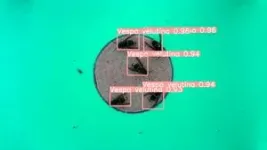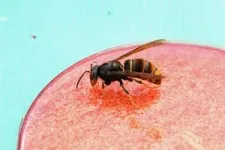(Press-News.org) Artificial Intelligence can be used to detect invasive Asian hornets and raise the alarm, new research shows.
University of Exeter researchers have developed VespAI, an automated system that attracts hornets to a monitoring station and captures standardised images using an overhead camera.
When an Asian hornet visits, VespAI can identify the species with almost perfect accuracy – allowing authorities to mount a rapid response.
Asian hornets (also known as yellow-legged hornets) have already invaded much of mainland Europe and parts of east Asia, and have recently been reported in the US states of Georgia and South Carolina.
The UK sits at the edge of the European invasion front, and with ongoing yearly incursions there is an urgent need for improved monitoring systems.
“Our goal was to develop something cost-effective and versatile, so anyone – from governments to individual beekeepers – could use it,” said Dr Thomas O’Shea-Wheller, from the Environment and Sustainability Institute on Exeter’s Penryn Campus in Cornwall.
“This study tested a prototype version, and the results were encouraging. VespAI shows promise as a robust early warning system to detect Asian hornet ingressions into new regions.”
VespAI uses a compact processor to operate, and remains dormant unless its sensors identify an insect within the size range of a hornet.
If this happens, the system’s AI algorithm activates, analysing the image to determine if it’s an Asian hornet (Vespa velutina), or native European hornet (Vespa crabro). If an Asian hornet is detected, the monitor then sends an image alert to the user, allowing them to confirm the identification.
At present, the UK response strategy depends upon people seeing, identifying and reporting Asian hornets. However, this has some limitations.
“Unfortunately, the majority of reports submitted are misidentified native species, meaning that the responsible agencies have to manually validate thousands of images every year – our system thus aims to provide a vigilant, accurate and automated surveillance capability to remediate this,” said Dr Peter Kennedy, who conceptualised the system.
“In some parts of Europe, detection relies on hornet trapping – but such traps kill a lot of native insects, and do little to impact Asian hornet numbers.
“VespAI does not kill non-target insects, and thus eliminates the environmental impact of trapping, while ensuring that live hornets can be caught and tracked back to the nest, which is the only effective way to destroy them.”
During the project, the system was tested extensively on the island of Jersey, which experiences high numbers of Asian hornet incursions due to its proximity to France.
While this exposed the monitor to both Asian hornets, European hornets and a variety of other insects, VespAI’s detection algorithm successfully distinguished between each of these, even when present in large numbers.
“That’s the benefit of our system – its high accuracy means that it won’t wrongly identify other species, or miss any Asian hornets that visit,” said Dr O’Shea-Wheller.
The research project included both biologists and data scientists from the University of Exeter’s Environment and Sustainability Institute, Centre for Ecology and Conservation and Institute for Data Science and Artificial Intelligence.
This year, the team will begin deploying additional prototypes in collaboration with Defra, the National Bee Unit, the British Beekeepers Association and Vita Bee Health.
With 2023 seeing record numbers of Asian hornet sightings in the UK, the system aims to bolster exclusion efforts at a potentially crucial juncture.
“The proposed device may prove a powerful tool in the early determination of the presence of Asian hornets in an area, and thereby fills an important gap,” said Alistair Christie, Senior Scientific Officer for Invasive Species in Jersey, and part of the collaborative testing effort.
The project was funded by the Biotechnology and Biological Sciences Research Council (BBSRC), part of UKRI.
The paper, published in the journal Communications Biology, is entitled: “VespAI: a deep learning-based system for the detection of invasive hornets.”
END
AI helps to detect invasive Asian hornets
2024-04-03
ELSE PRESS RELEASES FROM THIS DATE:
Pressure determines which embryonic cells become ‘organizers’
2024-04-03
(Santa Barbara, Calif.) — A collaboration between research groups at the University of California, TU Dresden in Germany and Cedars-Sinai Guerin Children’s in Los Angeles has identified a mechanism by which embryonic cells organize themselves to send signals to surrounding cells, telling them where to go and what to do. While these signaling centers have been known to science for a while, how individual cells turn into organizers has been something of a mystery.
Until now. In a paper published in the journal Nature ...
Global rollout of Skin Observer by NAOS and Haut.AI in 2024
2024-04-03
Tallinn, 3rd April 2024 - 10 AM CET – NAOS, the French founding company behind pioneering ecobiological skincare brands BIODERMA, Etat Pur, and Institut Esthederm, introduces its innovative new digital tool Skin Observer in collaboration with Haut.AI, a leader in AI applications for skincare and skin aging. The partnership merges cutting-edge AI technology with deep expertise in skin ecobiology.
Developed in collaboration with dermatologists, NAOS Skin Observer offers quick and precise skin analysis, recommending customized rituals adapted to individual skin types. The system adjusts routines based on user preferences, dynamic skin ...
New Paradigm of Peace through Health: Traditional Medicine Meditation in the Prevention of Collective Stress, Violence, and War
2024-04-03
A breakthrough perspective article in Frontiers in Public Health, "Peace through Health: Traditional Medicine Meditation in the Prevention of Collective Stress Violence and War," sheds light on the profound impact of the Transcendental Meditation (TM) program on fostering global peace. The article reviews and analyzes the demand for public health and medicine to help prevent collective violence and “intractable” wars in the Middle East, Eastern Europe, Africa and elsewhere and ...
Machine learning enables viability of vertical-axis wind turbines
2024-04-03
If you imagine an industrial wind turbine, you likely picture the windmill design, technically known as a horizontal-axis wind turbine (HAWT). But the very first wind turbines, which were developed in the Middle East around the 8th century for grinding grain, were vertical-axis wind turbines (VAWT), meaning they spun perpendicular to the wind, rather than parallel.
Due to their slower rotation speed, VAWTs are less noisy than HAWTs and achieve greater wind energy density, meaning they need less space for ...
E-cigarette users now more likely to quit traditional cigarettes
2024-04-03
A new paper in Nicotine & Tobacco Research, published by Oxford University Press, finds that smokers who switch to electronic cigarettes are now more likely to stop smoking regular cigarettes. In the past, smokers who began using electronic cigarettes mostly continued smoking.
Electronic nicotine delivery systems first emerged on the U.S. market in 2007. The first e-cigarettes resembled conventional cigarettes (in appearance) and used fixed low-voltage batteries. Beginning in 2016, manufacturers introduced e-liquids containing nicotine salt formulations. These new e-cigarettes became widely available. These nicotine salts are lower in pH than freebase formulations, which allow manufacturers ...
Chatbot guides women through post-prison challenges
2024-04-03
Most women leaving prison face profound disadvantages and rarely have access to the resources needed to settle back into the community. Seemingly simple tasks such as obtaining replacement identification documents or opening a bank account become tangled in complexities.
Now researchers at the University of South Australia are co-designing a chatbot to help formerly incarcerated women re-establish their lives on the outside, and reduce the risk of them returning to prison.
Led by a team of UniSA researchers in collaboration with advocacy group Seeds of Affinity, the tech-based solution aims to help women access trusted ...
Doctors on front line of tackling childhood obesity but more training and resources needed
2024-04-03
Doctors are feeling unable to tackle growing problem of childhood obesity due to a lack of training and capacity according to new research.
In a paper published in the British Journal of General Practice, researchers from the University of Birmingham conducted in-depth interviews with healthcare professionals (HCPs) to understand their experiences of supporting families to tackle childhood obesity.
One participant in the study said:
“I had one mum and her child was overweight, but she was a young parent and she actually didn’t know how to cook the dinners and, yeah… we spent a lot of time with her giving her ...
Galaxies get more chaotic as they age
2024-04-03
Galaxies start life with their stars rotating in an orderly pattern but in some the motion of stars in more random. Until now, scientists have been uncertain about what causes this – possibly the surrounding environment or the mass of the galaxy itself.
A new study, published in a paper today in MNRAS (Monthly Notices of the Royal Astronomical Society), has found that the most important factor is neither of these things. It shows the tendency of the stars to have random motion is driven mostly by the age of the galaxy – things just get messy over time.
“When we did the analysis, we found that age, consistently, whichever way we slice or dice it, is always the most ...
Sandia pumps $140B into the economy through technology development
2024-04-03
ALBUQUERQUE, N.M. — To say that the technology and products Sandia National Laboratories researchers have helped imagine, innovate and industrialize have had a massive impact on the country would be an understatement.
Two studies commissioned by Sandia and the National Nuclear Security Administration show Sandia’s work has had an overall economic impact of $140 billion since the year 2000. That’s a significant figure, especially considering it spans just 20 years, less than a third of Sandia’s 75-year existence.
“I am very proud of how Sandia excels in fulfilling its technology transfer mission to deliver economic impact to the U.S.,” ...
Even moderate alcohol usage during pregnancy linked to birth abnormalities, UNM researchers find
2024-04-03
University of New Mexico researchers have found that even low to moderate alcohol use by pregnant patients may contribute to subtle changes in their babies’ prenatal development, including lower birth length and a shorter duration of gestation.
In a new paper published in the journal Alcohol Clinical & Experimental Research, a team led by Ludmila Bakhireva, MD, PhD, MPH, professor and assistant dean for Clinical and Translational Research in the UNM College of Pharmacy, also reported some sex-related differences in the effects of drinking during pregnancy on the developing ...







